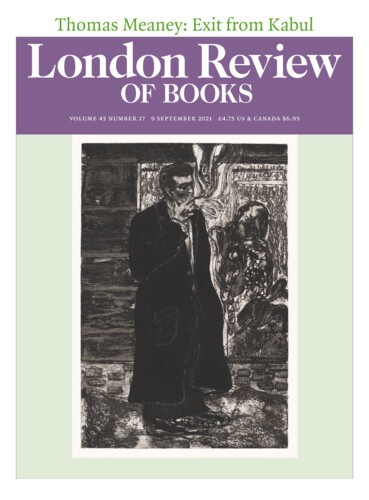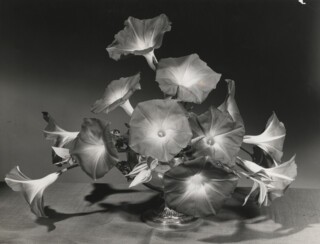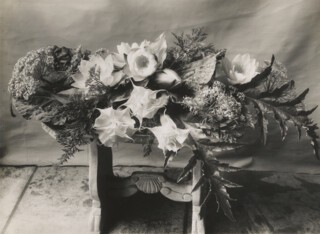Flower arranging occupies a lowly rung in the English cultural hierarchy. Somewhere between handicraft and hobby and associated mostly with women, it conjures up images of 1950s housewives filling the suburban afternoons or savage competition at the WI. Constance Spry had no time for any of that. The first and still one of the few flower arrangers to become a household name, she pointedly distanced herself from the postwar Flower Arrangement Societies she had inadvertently inspired. The societies favoured contests with set themes and complicated rules, while Spry’s books advised readers to pursue their personal ‘sense of beauty’ and not to ‘compromise with convention’.
Her own career began in the 1920s with the interwar avant-garde. Her first client was the Granada cinema chain. Seeking to distinguish itself from the sleek, moderne style of the Odeons, Granada commissioned elaborate interiors by the Russian émigré stage designer Theodore Komisarjevsky, in a style best described as Art Deco Gothic. Spry’s decorations were similarly exuberant at a time when the prevailing taste was for stiff, formal arrangements. Perfect blooms, ‘fresh like frilled linen clean from a laundry’, are what the ‘button-faced’ florist Miss Pym offers Clarissa Dalloway, shopping in Old Bond Street on the day of her party. Across the road, Mrs Dalloway observes, is ‘Atkinsons Scent shop’ and it was there, three years after Mrs Dalloway was published, that Spry got her big break in November 1929. The exhibition at the Garden Museum (until 26 September) includes two display cases from the original shop. Elaborately carved with foliage and pineapples and dragged or scumbled with white paint, they are a baroque variant of the so-called Vogue Regency style made fashionable by Spry’s friend the decorator Syrie Maugham. Spry’s arrangements for Atkinson’s four big windows were made up of what she called ‘weeds’, plants that looked less as if they had come from the laundry than as if they were making their way home after an exciting night out. They included brambles and chartreuse green cymbidium orchids in trailing arrangements that brought passers-by to a halt. Spry’s reputation was made. She worked with Cecil Beaton and Oliver Messel and began to acquire her own celebrity clients. When Beaton photographed Wallis Simpson in 1937 wearing the notorious ‘lobster’ dress by Elsa Schiaparelli and Salvador Dalí, she posed with branches of foliage supplied by Spry, who later did the flowers for the Windsors’ wedding.
Spry herself was not conventional. The Garden Museum’s elegant exhibition manages, in three small galleries, to convey the densely layered nature of a career that combined art, entrepreneurism and world fame with a private life in which two marriages, one unhappy, one less so, were the background to a blazing affair with the artist Hannah Gluckstein, known as Gluck, which lasted four years and ended as abruptly as it began. Spry’s professional success was the more remarkable for the fact that when she opened her first shop in 1929 she was already in her early forties and had another very different career behind her. She was born in 1886 in Derby, where her father worked as a railway clerk. The family moved to Ireland when she was fourteen and she trained in Dublin, and later in London, in hygiene, district nursing and sanitary inspection. She became a professional lecturer for the Women’s National Health Association and toured Ireland in a caravan teaching first aid and home nursing to women. The First World War offered a way out of her violent and miserable first marriage to James Marr and she came to London with her young son to take up a position at the Ministry of Munitions, responsible for women’s welfare in the department of aircraft manufacture. After the war she changed her surname to Spry, implying that she was married to Henry Ernest Spry, with whom she lived for the rest of her life. Opinion is divided as to whether or not they were ever married – the Garden Museum and the DNB disagree – but no doubt the Homerton and South Hackney day continuation school, of which Constance became principal in 1921, was under the impression that they were.
Her main interest and comfort through the vicissitudes of this often difficult early life was gardening. ‘I was first, and hope last to be, a gardener,’ she wrote years later. By the time she opened her first shop, in Belgrave Road, she was already a knowledgeable plantswoman with an important collection of old roses, and she went on to build a library of 18th and 19th-century flower books. Flower Decorations, as the shop was called to distinguish it from a florist, offered arrangements that were unusual not only for the choice of flowers but also for their characterful settings. Spry rarely used vases, preferring glasses or jugs found in junk shops, even baking tins. She commissioned bespoke designs from the Fulham Pottery in a variety of wide, shallow shapes, glazed inside but left matt on the exterior so they could be coloured to harmonise with a particular scheme. Belgrave Road was not a great success. Victoria was too far off the beaten track of the smart set, so she moved to South Audley Street, Mayfair, in 1934. Already, according to Vogue, ‘one of the essential figures behind the scenes of social life’, Spry now stepped into the limelight. In 1935 she got her first royal commission, for the wedding of the Duke of Gloucester, and by 1939 she had seventy employees. Her New York shop, which opened in 1938, looked like an ocean liner, with white cane chairs, quilted wall coverings and flowers shown in vast vitrines, appearing to float like fish in aquariums.
The Garden Museum understandably consigns Spry’s first career to a single text panel outside the main exhibition, but there is no doubt that decades of teaching and administration, the caravan tours in the poorer parts of rural Ireland and running a school in the London slums stood her in good stead. She was pragmatic, good at organisation and determined to get the job done. Writing for a women’s magazine about her decorations for the coronation in 1953, a career highlight which won her an OBE, she explained the unglamorous reality of ethereal effects created with chapped hands and broken fingernails in a state of mental agony about whether the flowers would arrive on time. It was, she said, like ‘those nightmares in which you find yourself improperly clothed in a public place’. In 1934 she published the first of thirteen books, all with straightforward titles such as How to Do the Flowers and Party Flowers. She made an LP, The Arrangement and Care of Flowers, and her lecture tours of America and Australia were a roaring success. During a month-long trip to the US she spoke at 21 venues from New York to Los Angeles, returning by way of New Orleans and Dallas. In Australia her assistants were delighted to discover that her delicate sense of colour and texture was accompanied by huge stamina and salty humour. For her farewell card they drew a cartoon of Spry galloping along with neatly permed hair and showing a lot of leg, while a drooping dahlia carries her bags and an exhausted bee salutes. The verses inside, ‘to be sung in a rollicking manner but with a haunted expression’, conclude: ‘How nice to have met Mrs Spry/(you say no? Then here’s/mud in your eye!)//With her store of blue jokes/About sheilas and blokes/We’re sad to be saying goodbye.’
The 1930s and 1940s saw Spry at work on a succession of society weddings. The only relic of these in the show is the Duchess of Gloucester’s faded headdress of wax orange blossom, which inevitably has a forlorn, Miss Havisham air. But magazine cuttings and Spry’s own descriptions evoke the excitement of occasions such as that on which ‘novelist’s daughter’ Elizabeth Mary Somerset Maugham married Mr Vincent Paravicini in a green and white lamé creation by Schiaparelli carrying a ‘crescent bouquet of mixed white flowers’ by Flower Decorations Ltd. ‘London’s most original wedding for many years’ was Nancy Beaton’s to Sir Hugh Smiley at St Margaret’s, Westminster, for which Spry used palm leaves and hazel branches, frosted and sprayed with chalk, attached to Venetian posts on either side of the aisle and then massed in the chancel. The effect was so impressive that ‘many of the guests so forgot themselves as to stand on the pew seats … to get a better view.’ The pale branches reflected the fact that it was a winter wedding. Spry believed in following the changing seasons, and is heard in a recording at the exhibition evoking their various qualities: the tenderness of spring and the power of autumnal colour. Do not underestimate, she concludes, ‘the strength and austerity of a leafless branch’. She knew how to create drama with simple effects. For the coronation she used glass candelabra in which the candle holders were filled with flame-like arrangements, ‘slender pointed posies, made of tiny flowers’.
In the mid-1930s her own marriage, or ménage, with Harry ‘Shav’ Spry was going through a difficult period. When the designer Prudence Maufe ordered some flowers for Gluck, Spry sent an arrangement of convolvulus so perfect that Gluck was inspired to paint it. When Spry came to see her new, enthusiastic client, they fell instantly in love. After this interlude, which ended when Gluck met Nesta Obermeyer, Spry seems to have gone back to Harry for good. She remained committed to the wellbeing of women, as an employer and an instructor, through both phases of her career. One of the most revealing documents in the exhibition is a list of employees and salaries from 1947. Spry, on £600 a year, was not the highest paid: that was R. Dickson, presumably a manager, on £750. Few of the mostly female workforce earned less than £200 a year, the lowest paid being the two apprentices, Doreen Garrick and Janet Jones, on £100 and £90 respectively. In 1946 Spry set up a residential college, Winkfield Place, with a vision for the postwar woman that was the antithesis of the Flower Arranging Societies. She intended Winkfield to be an anti-finishing school, or as she called it, a ‘starting school’. ‘A working knowledge of both gardening and cooking,’ she wrote, would give young women ‘an added confidence about living, a talisman in times of stress and a reassuring sense of independence and power’.
Send Letters To:
The Editor
London Review of Books,
28 Little Russell Street
London, WC1A 2HN
letters@lrb.co.uk
Please include name, address, and a telephone number.



